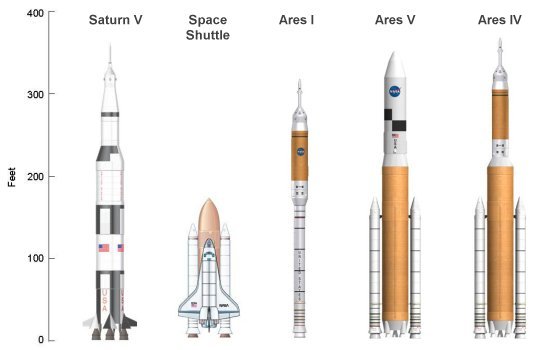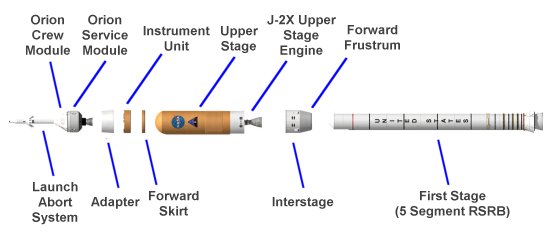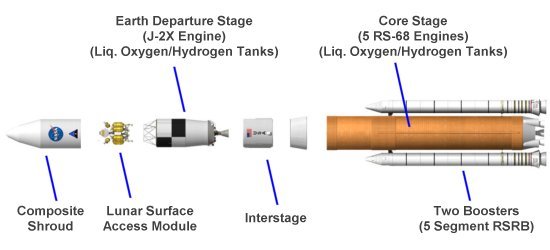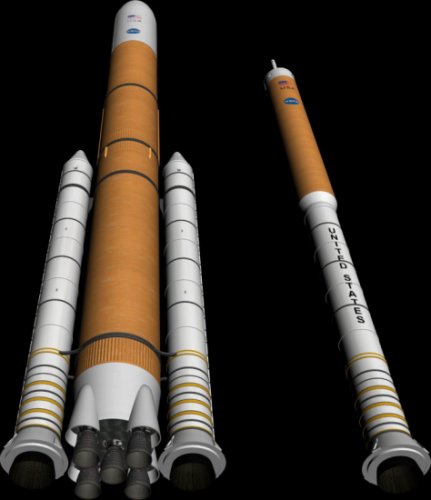|
||||||||||
|
|
||||||||||
|
||||||||||
|
|
||||||||||

The initial Project Constellation vehicle is the Ares I. The first stage of the rocket is a modified Space Shuttle SRB that is longer and uses a different central bore shape to increase the burn rate. Like today's boosters, this first stage can be recovered and reused should it prove cost-effective to do so. Riding atop the SRB is a new expendable second stage using liquid hydrogen and liquid oxygen propellants stored in tanks similar to those of the current Shuttle ET. The second stage was to have used a modified SSME from the current Shuttle, but it would have required extensive redesign. NASA has instead opted for a J-2X engine based on the J-2 originally used on the Saturn series. At the top of the assembled vehicle are the new manned Orion crew and service modules, based on those used for Apollo missions, and an emergency escape system.

Complementing the Ares I is the larger Ares V. Whereas the Ares I is designed to launch the manned Orion capsule, the Ares V is an unmanned heavy lift vehicle for launching cargo into Earth orbit and beyond. The Ares V also uses two of the new five-segment Redesigned Solid Rocket Boosters (RSRBs) and a central core rocket derived from the External Tank of the current Shuttle. This core stage is longer and wider than the current ET but uses the same construction techniques and foam insulation. The most significant change is that the core stage carries five liquid rocket engines in its base. These engines were originally to be derived from the current SSME design used on the Space Shuttle, but new RS-68 engines are being substituted to reduce cost and improve performance.

The second stage of the Ares V is the Earth Departure Stage based on the second stage of the Saturn V and Saturn IB rockets used during the Apollo program. This stage is powered by a single J-2X liquid rocket engine that can boost a large payload, such as a Lunar Surface Access Module (LSAM), into a circular orbit around Earth. The LSAM is based on the Lunar Module used during Apollo but much larger for a bigger crew and longer duration missions. For a lunar landing mission, an Orion capsule launched by the Ares I and carrying a crew of astronauts will rendezvous and dock with the second stage and LSAM already in orbit. The Earth Departure Stage is then ignited a second time to boost the Orion and LSAM on its way to the Moon. A similar technique is envisioned for missions to Mars.
NASA has also announced a new derivative under consideration called the Ares IV. While little information is available so far, this rocket appears to merge the core stage and twin boosters of the Ares V with the upper stage and Orion capsule of the Ares I. This design might allow NASA to discontinue the Ares I in favor of a launch vehicle with greater commonality with the Ares V to reduce development costs and use the same launch pad infrastructure. Performance would also improve since the Ares IV can launch a considerably larger payload into higher orbits than the Ares I. The primary disadvantage is the increased cost per flight since the Ares IV requires a much larger and more complex first stage than the Ares I.

The component of the Space Shuttle that environmentalists have most frequently criticized is the Solid Rocket Booster, which is also a major component of all the Project Constellation launch vehicles. One of the byproducts of the chemical reaction as the solid propellants are burned is chlorine. Large amounts of chlorine high in the stratosphere attack ozone and cause it to break down. Earth's ozone layer absorbs ultraviolet radiation from the Sun and protects life on the surface from this cancer-causing radiation. However, studies have shown that the amount of chlorine produced by the Space Shuttle and other rockets using similar solid propellants is actually quite small and has a miniscule effect on the ozone layer.
Independent atmospheric modeling studies performed by NASA and private research firms in 1990 and 1991 indicated that the vast majority of chlorine present in the stratosphere is produced by industrial or natural sources. In an average year, industry generates an estimated 300 million kilograms of stratospheric chlorine while natural sources like volcanoes produce about 75 million kilograms. Assuming nine Space Shuttle launches and six launches of Titan rockets per year results in a total of 725,000 kilograms of chlorine released into the upper atmosphere. The actual launch rate of the Shuttle has only been this high once, in 1985, and is generally much lower with an historic average of less than five launches per year.

Even at the highest launch rate, however, Space Shuttle and Titan launches add less than 0.25% of the total
chlorine present in the upper atmosphere. This tiny amount of chlorine would decrease the yearly average of global
ozone by just 0.0065%. This reduction is far less than even the variation in ozone levels due to natural phenomena
like volcanic eruptions and solar flares. The launch rate of vehicles with solid rocket boosters would have to be
increased by at least two orders of magnitude to have a comparable effect on the ozone layer as natural processes.
- answer by Joe Yoon, 18 March 2007
Read More Articles:


|
Aircraft | Design | Ask Us | Shop | Search |

|
|
| About Us | Contact Us | Copyright © 1997- | |||
|
|
|||